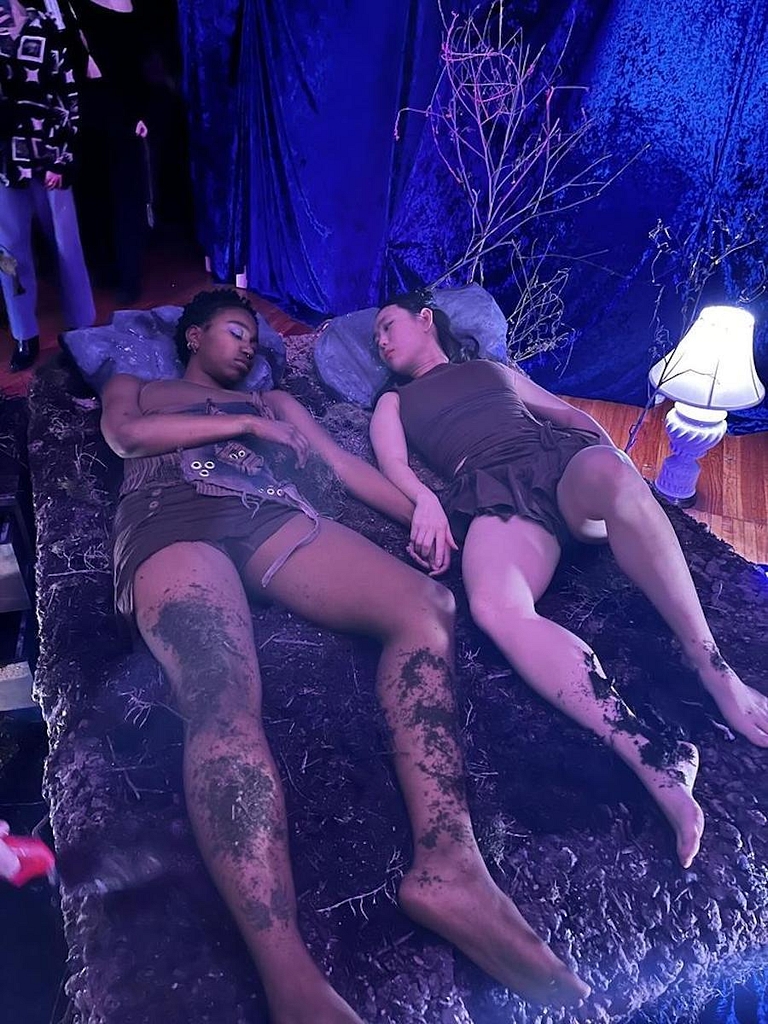LA
Glass House Is A Smash
by | Mar 11, 2024 2:02 pm
Post a Comment | E-mail the Author
Posted to: Theater

GLASS HOUSE
VOLTA COLLECTIVE and CENTRAL SERVER WORKS
G‑SON Studios
Los Angeles
Closed
You enter not a room but a realm. Dreamlike, the space is bathed in deep, indigo velvet and moody music. In three corners are three discrete sculptural set pieces with dancers: five or so figures encased in a crate of shredded black gauze, two figures embracing tightly — as one — in a water-filled tub, and a queen-sized bed seemingly made of mud where two more bodies entwine. As an audience member, you are encouraged to interact with these installations.
You take a seat and things explode: a narrator appears and delivers a searing, descriptive text about abusive parenting; a hyperkinetic score picks up steam; and the bodies emerge to crash through this psychic space.
You’re in Glass House, a shimmering, shattering, immersive, layered, intermedia performance from Volta Collective and Central Server Works that peers into “the psychological construction of home.”
A recent Flaunt interview with director and choreographer Mamie Green encapsulates the concept. Green was drawn to C. G. Jung’s theory of the “dream house”: “The idea that the architecture of our psyches [is] built upon our unique experiences.” Jung’s diaries are rich with this symbolism, and Green creates a house that pulses with mental disruption and colliding emotion.
The script by Sammy Loren and Zoey Greenwald both illuminates and scrambles the abuse theme:
But then I am inside Daddy’s house. The weight of his footsteps echoes in my ears. Circling the hallway to my room or battling Mommy. The two of them chase each other’s shadows, starving, hysterical, naked, dragging themselves through the living room.
According to the project statement, the text “weaves elements from memoirs and reflections on home,” with mash-ups of writers such as Abdellah Taïa, Adania Shibli, Marguerite Duras, and Joan Didion. In the above passage, one detects Allen Ginsberg as well.
Jance Enslin delivers this script, and Volta’s gifted dancers clash, climb, mount, bound, smash and sway, often avoiding eye contact. They are DNA billiard balls unraveling to Patrick Shiroishi’s score. It, too, erupts in fragments, or rolls in syncopation. In key sequences, the bodies throb and head-bob jointly in the folding chairs. These sections have an opiated vibe, hypnotized by Shiroishi’s grooves, which sometimes seem to echo the fractured pop of composer Carl Stone mixed with dark, late-period electric Miles Davis. It’s intoxicating.
Also winning are Gbenga Komolafe’s art direction and elaborate, sculptural set pieces. These the spectators can inspect before the dancers explode around them … especially the bed, which becomes a stage for their movement. Uniting everything is Ryan Brennan’s production design and Webb Hinton’s lighting, which utterly transform the performance’s 1930s barrel-vault building into this haunted house. The performers, costumed by Anya Gta, are Anne Kim, Avery Gerhardt, Cacia LaCount, Chadwick Gaspard, Paul Liu, and Joylyn Lambey, along with Green and Enslin.